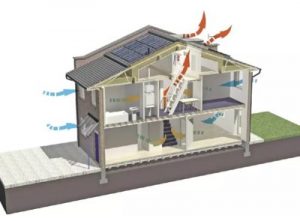Hệ thống thông gió cho nhà ống là giải pháp không thể thiếu để đảm bảo không khí lưu thông, giảm nóng bức và ngột ngạt trong không gian sống vốn hẹp và dài đặc trưng của loại hình nhà ở này. Với đặc điểm ít mặt thoáng, khó tiếp cận ánh sáng và gió tự nhiên, nhà ống rất dễ tích tụ khí độc, ẩm mốc và thiếu oxy nếu không có hệ thống thông gió hiệu quả. Việc thiết kế và lắp đặt đúng cách không chỉ giúp cải thiện chất lượng không khí mà còn nâng cao sức khỏe, tiết kiệm năng lượng và gia tăng giá trị sử dụng cho ngôi nhà.
Dưới đây là 8 giải pháp hiệu quả giúp cải thiện luồng không khí trong nhà ống, mang lại không gian sống dễ chịu và trong lành hơn.
1. Tăng cường giếng trời để đón gió và ánh sáng tự nhiên
Giếng trời là một trong những giải pháp hiệu quả và ít tốn điện nhất để hỗ trợ thông gió cho nhà ống. Vị trí lý tưởng để đặt giếng trời là giữa nhà hoặc phía sau, nơi ít được tiếp xúc với gió trời.
- Ưu điểm: Tạo lối thoát khí nóng, giúp đối lưu không khí tốt hơn.
- Lưu ý: Nên kết hợp với mái kính, lam che hoặc quạt hút đặt trên nóc giếng để tăng hiệu quả trao đổi khí.
2. Cửa sổ thông tầng và cửa lùa lấy gió chéo
Thiết kế cửa sổ đối lưu ở hai đầu nhà hoặc ở khu vực cầu thang là cách tối ưu để không khí được đẩy qua nhà từ trước ra sau. Nếu không đủ diện tích mở cửa sổ, bạn có thể sử dụng cửa lùa kết hợp cửa chớp hoặc ô thông gió cao sát trần.
- Ưu điểm: Đón được gió tự nhiên, giảm phụ thuộc thiết bị điện.
- Lưu ý: Hạn chế dùng cửa sổ dạng mở quay ở không gian hẹp vì dễ bị chắn gió.
3. Bố trí khe thông gió giữa các tầng hoặc tường liên kết
Trong thiết kế nhà ống, các tầng thường bị “ngăn cách” kín. Việc bổ sung khe thoáng tường đứng, hoặc hệ thống lỗ gió giữa các phòng, giúp luồng khí di chuyển theo chiều dọc từ dưới lên trên.
- Ưu điểm: Tạo dòng đối lưu giữa các tầng, giảm khí nóng tích tụ.
- Lưu ý: Khe gió cần được che chắn bằng vật liệu chống bụi, chống côn trùng.
4. Lắp đặt quạt thông gió âm trần hoặc gắn tường
Đây là giải pháp phổ biến trong các hệ thống thông gió cho nhà ống, đặc biệt trong phòng ngủ, phòng làm việc và nhà vệ sinh – những nơi dễ bị bí khí.
- Ưu điểm: Chủ động hút khí nóng, ẩm ra ngoài; hoạt động độc lập từng khu vực.
- Gợi ý: Nên chọn quạt thông gió có độ ồn thấp (dưới 35 dB) và tiết kiệm điện.
5. Sử dụng quạt cấp khí tươi kết hợp lọc không khí
Khi không khí bên ngoài ô nhiễm hoặc quá nóng, bạn có thể sử dụng hệ thống cấp khí tươi có màng lọc. Loại thiết bị này hút không khí sạch từ ngoài vào, sau đó phân phối đều trong nhà qua các ống dẫn khí.
- Ưu điểm: Đảm bảo nhà luôn có không khí mới mà vẫn sạch bụi, vi khuẩn.
- Lưu ý: Cần bảo trì định kỳ bộ lọc để đảm bảo hiệu quả.
6. Thiết kế mái thông gió hoặc mái kính có khe thoát khí
Nếu mái nhà có độ dốc hoặc đủ diện tích, bạn có thể lắp mái thông gió kiểu chữ A, hoặc mái kính lấy sáng có khe thoát nhiệt.
- Ưu điểm: Giúp khí nóng bốc lên được đẩy ra ngoài tự nhiên.
- Gợi ý: Nên kết hợp mái kính với film cách nhiệt hoặc kính phản quang để tránh tăng nhiệt trong nhà.
7. Hệ thống thông gió thu hồi nhiệt
Với những ngôi nhà ống hiện đại, kín khí và sử dụng điều hòa thường xuyên, hệ thống thông gió thu hồi nhiệt là lựa chọn lý tưởng. Thiết bị này giúp trao đổi không khí trong – ngoài nhưng vẫn giữ nhiệt độ trong nhà ổn định.
- Ưu điểm: Tiết kiệm năng lượng, lọc sạch bụi mịn PM2.5, điều hòa độ ẩm.
- Lưu ý: Đầu tư ban đầu cao hơn, nhưng hiệu quả dài hạn vượt trội.
8. Tự động hóa hệ thống thông gió cho nhà ống
Việc tích hợp cảm biến độ ẩm, nhiệt độ hoặc lập trình hẹn giờ sẽ giúp hệ thống vận hành thông minh, tiết kiệm điện năng và đảm bảo luôn có luồng không khí sạch, dù gia chủ không ở nhà.
- Ưu điểm: Tối ưu hiệu suất, giảm chi phí vận hành.
- Gợi ý: Nên sử dụng bộ điều khiển trung tâm cho nhà nhiều tầng.
Kết luận
Việc lựa chọn hệ thống thông gió cho nhà ống không nên chỉ dựa vào một thiết bị riêng lẻ. Một giải pháp lý tưởng cần được thiết kế tổng thể từ kiến trúc (giếng trời, khe thoáng) đến thiết bị (quạt hút, máy cấp khí, hệ thống thu hồi nhiệt). Nếu bạn đang có nhu cầu tìm kiếm đơn vị thiết kế và thi công trọn gói hệ thống thông gió trong nhà, vui lòng liên hệ SECOTAB để được tư vấn chi tiết.














